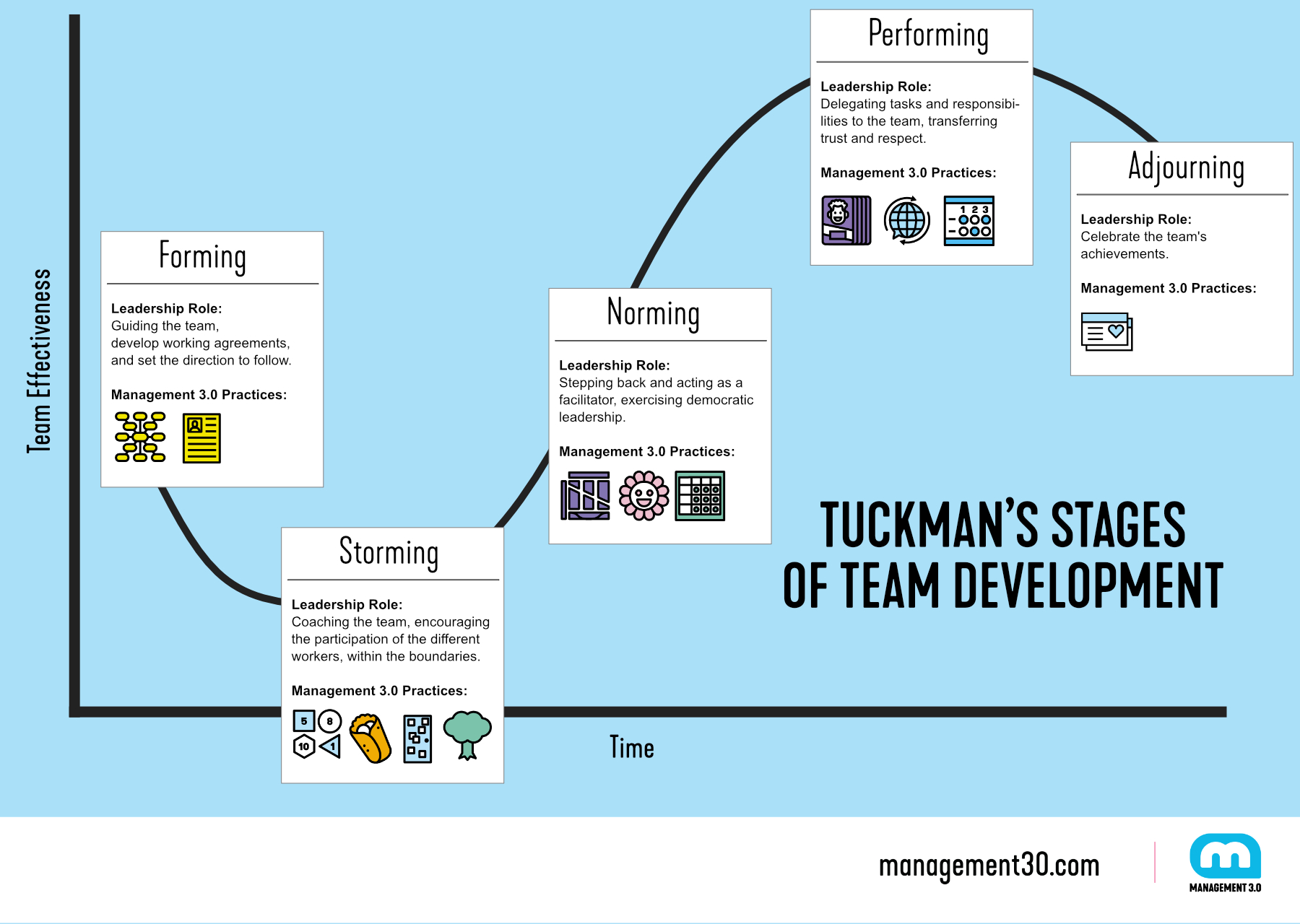An article by Agile Coach and Management 3.0 Facilitator Juan Mello, who gave a talk at the Agile Week conference last year, talking about the Tuckman model and how Management 3.0 practices can help us in every stage.
The 5 Stages of the Tuckman Model: Forming | Storming | Norming | Performing | Adjourning
I love Tuckman’s model because it explains the different stages of team development in an obvious way, helping me understand my teams and have a better understanding of how to help and support them in my role as an Agile Coach.
However, before talking about the model itself and how Management 3.0 comes in, I want to share something that worked pretty well for me: Compare Tuckman’s model to the periods of human development of every person, as suggested as well by S. Wheelan and The Integrated Model of Group Development, see this article for reference.
Comparing Tuckman’s model to the periods of human development
With this in mind, we can quickly identify these stages:
Childhood
It is the stage in which kids need a lot of accompaniment and support. They constantly learn new things, about their context and also about themselves.
Adolescence
It’s a period of change and conflict. Physical, attitude, and behavior change take place, sometimes in a very rapid way. At the same time, the need to find an identity becomes very important.
Young Adulthood
Here, young adults become individuals and work to become independent from their parents. They take responsibility for themselves and make their own decisions. In this stage, young adults learn from tangible and intangible things and experiences.
Middle Adulthood
People are better at handling the stresses of life and have gained experience in what they do. Knowledge and experience help the person make better decisions.
Late Adulthood
This final stage is related to the person’s retirement. It’s a stage of acceptance of a more leisurely and relaxed life.
But how does this relate to team development?
What you will see in this article is the Tuckman model, it’s stages of team development, and how they are associated with human development.
Also, I want to explain how the Management 3.0 practices can help us in every stage.
The 5 Stages of the Tuckman Model
Stages that teams go through, according to Tuckman
Achieving high-performance teams is not a goal that an organization or manager can achieve overnight.
To collaborate in this mission, Bruce Tuckman modeled the different phases that teams go through until they transform into high-performance teams. His theory was embodied in his essay: “Developmental sequence in small groups”, developed from his research and observation of group behavior in different settings.

The Tuckman model proposes the following five stages:
First Stage: Forming
We can think of this stage as childhood.
The team is just formed after its composition, so the team members don’t know each other, and they don’t have a clear understanding of the purpose and vision of the team.
We can see disparate behaviors depending on the personalities of each member, from professionals who try to stand out or, on the contrary, those who tend to be reactive due to their insecurity.
The role of the leader in the Forming stage
The key is to exercise paternalistic leadership, guide the team, develop working agreements, and set the direction to follow and the tasks the team needs to carry out. However, it is also essential that we pay attention to the qualities of each worker, identifying the strengths that each one can bring to the team.
How Management 3.0 comes in during the Forming stage
These practices will help us in this stage:
- Personal Maps: Increase trust and connections with the team.
- Work Profile: Think about job titles not as a specific role but as the value they add.
- Identity Symbols: Give a sense of belonging to the team defining their name and and image.

Second Stage: Storming
We can think of this stage as adolescence.
Different members start losing their shyness and begin to express their characteristics and points of view.
This consolidation of interpersonal relationships will lead to the creation of subgroups, the appearance of contradictory opinions, and, with them, the first conflicts, frictions, and struggles for power appear.
The role of the leader in the Storming stage
In this phase, the team must understand that conflicts are good and healthy things for the team, but they need to work on them.
The leader will coach the team, encouraging the participation of the different workers, but within the boundaries of a climate of dialogue and assertiveness, which enriches the group. For this, it is crucial to work on the team’s values and define processes and structures that clarify group and individual functioning. It is also time to assess whether the diversity of the team is adequate.
How Management 3.0 comes in during the Storming stage
These practices will help us on this stage:
- Diversity Index: Understands the importance of diversity in a team and how it makes them stronger.
- Feedback Wrap: Creates a healthy culture through constructive feedback.
- Happiness Door: Gives another tool for the team to provide visible feedback and express their opinions and points of view.
- Value Stories: Guides the team to find individual and team values.

Third Stage: Norming
We can think of this stage as young adulthood.
The team will evolve towards a stage in which the conflict gives way to understanding and cohesion. This does not mean that we do not find different points of view, but in this phase, each person is aware of their role and function in the team and knows that their contributions must be aimed at improving results beyond individual ambitions.
The role of the leader in the Norming stage
This good harmony allows the leader to take a step back and act as a facilitator, exercising, for example, democratic leadership where the team considers all professionals in decision-making.
Also the team needs to focus on learning from their mistakes and celebrating the good things.
Management 3.0 practices for Norming stage
These practices will help us on this stage:
- Celebration Grid: Talk about the different experiments done and what the team learned about them.
- Moving Motivators: Understand individual and team intrinsic motivators.
- Team Competency Matrix: Find the competency gaps to work on to achieve the team’s goals.
- Team Decision Matrix: Helps the team think and agree on how they will make their daily decisions.
- Yay! Questions: Facilitates a transparent space to talk about what the team has learned and what went well.
- 12 Steps to Happiness: Connects the work with the team’s happiness.

Fourth Stage: Performing
We can think of this stage as middle adulthood.
Over time team coordination increases, reinforcing performance and reducing conflict and waste.
We are now in front of a high-performance team, capable of carrying out their tasks with a great degree of autonomy and an excellent level of effectiveness.
The role of the leader in the Performing stage
A good strategy is to delegate tasks and responsibilities to the team, transferring our trust and respect.
Management 3.0 practices for the Performing stage
These practices will help us on this stage:
- Change Management Game: How the team will face the changes they are involved in.
- Delegation Poker: Agree with the team on how tasks and responsibilities will be delegated.
- Kudos: Congratulate and recognize everyone’s good job and efforts.
- Niko-Niko Calendar: Visualize how everyone is and their mood.

Fifth Stage: Adjourning
We can think of this stage as late adulthood.
This fifth stage of the Tuckman model, introduced later, refers to when high-performance teams must disband because they have fully fulfilled their mission.
This separation will generate a double feeling: well-being for a goal achieved and sadness for the separation of colleagues they have managed to work with effectively.
The role of the leader in the Adjourning stage
In this case, the team leader should celebrate the team’s achievements to reinforce the professionals’ sense of pride and satisfaction and instil motivation for future assignments.
Management 3.0 tools for the Adjourning stage
These practices will help us on this stage:
- Kudos: Take a moment to recognize and thank the different team members for what they have done.

Despite other excellent maturity models you can find, I encourage you to analyze your teams and detect different behaviors and patterns based on Tuckman’s.
I’m sure it will help you understand your team better, and who knows, if you haven’t done it yet, you can start experimenting with some Management 3.0 practices and start seeing the results!
More resources on teambuilding:
- Management 3.0 module on Teams
- Helping Teams Discover Their Purpose
- The Secret to Creating High Performing Teams (Podcast)
- 8 Remote Team Leadership DO’s and DONT’s
- Management 3.0 tools for great Agile Coaches
Header photo by Brooke Cagle (via Unsplash)

